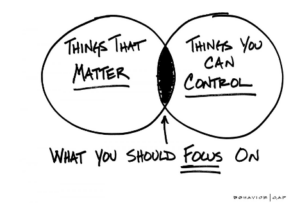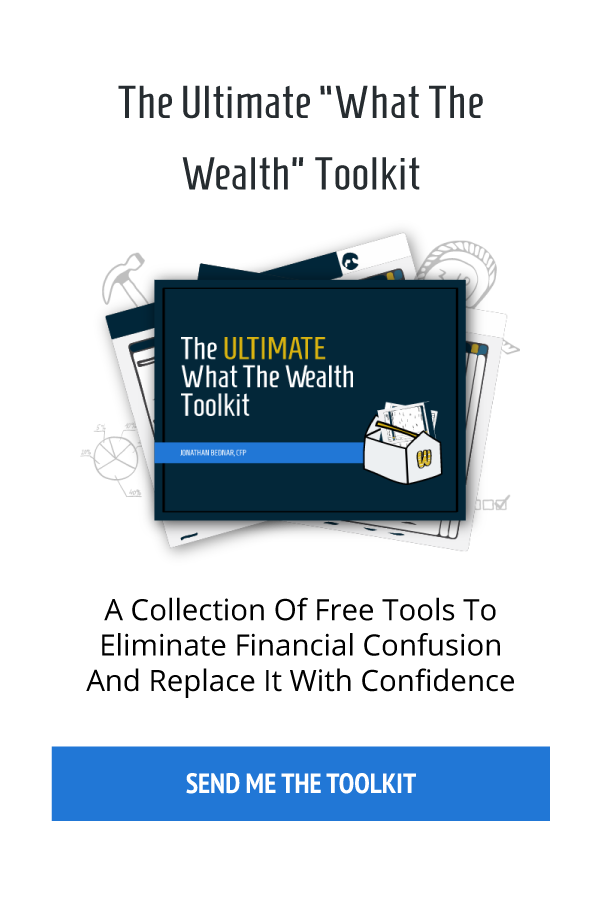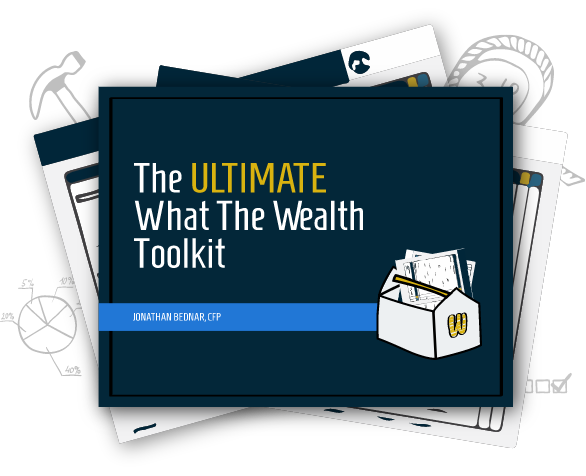Conversations with clients often inspire my podcast episodes, and today’s is one of those cases. Recently my clients have been talking about fear and anxiety, all of those “What ifs” that all of us ask ourselves.
Volatility and Risk
Many people confuse volatility and risk, including some financial professionals, or even think they are two different words for the same thing. But volatility and risk are two distinct things.
Volatility is the up-and-down market movement in prices and how those swings affect things like inflation, the economy, earnings, and the other things that drive the market.
Risk is the inherent loss of money.
Let’s use Apple as an example. Apple has lost 50% of its value many times in its four-decade history and even in the last five to ten years. That doesn’t mean Apple is worthless or at risk of going out of business. It simply means that the company is dynamic, subject to the economy and change, and periodically has to have a bit of a reset.
Of course, that doesn’t mean that Apple or other large, successful companies can’t go out of business. Look at what happened to Sears, KMart, and Blockbuster. Apple and all companies are subject to volatility, but the probability of the risk of an Apple becoming worthless is low in terms of risk, as we defined it above.
What If?
These are some of the What ifs my clients want to talk about lately. What if:
- The market continues to drop?
- The Fed continues pushing up interest rates?
- Inflation keeps rising?
- Putin nukes New York City?
- China’s Yuan becomes the world’s new reserve currency leaving the American dollar worthless?
Let me put your mind at ease about that last one, at least! The American dollar is very strong, at a two-decade high. Everyone wants dollars, so we’re not at risk of the dollar being unseated as the world’s reserve currency.
I ask my clients where these What ifs are coming from, but I already know the answer; the media, specifically the financial media. It’s these fear-mongering headlines causing the anxiety.
Reading the News is the New Smoking
Have you noticed in the last several years that every time there is any threat of a hurricane, the media ramps it up to 11? And most of the time, luckily, it turns out to be nothing. Have you wondered why the media blows things up like that? Katrina. The media saw big numbers mass covering the devastation Katrina caused, something that has become known as disaster porn.
The financial news has now become this same kind of disaster porn. And the media is more specialized now; we have entire channels, newspapers, magazines, websites, blogs, and podcasts dedicated to financial news, CNBC, Fox Business, and the Wall Street Journal, to name just a few.
Why do we watch endless coverage of bad news, financial or otherwise? We convince ourselves that we’re doing it to inform ourselves it’s important to be aware of the world around you on a local, state, national, and international level. We want to be able to have intelligent conversations around the news with the people in our lives. I believe we consume this media so that when we’re asked about XYZ, we have something intelligent to say.
This overconsumption is not good for us. Remember a few years ago when sitting was deemed the new smoking? Sitting for hours a day was thought to be just as bad for our health as smoking cigarettes. A few months ago, I came across an article titled Reading the news is the new smoking by Adam Mastroianni.
The article’s premise is that constantly reading and watching the news is bad for our physical and mental health. I don’t agree with every word and felt the article could have been more politically neutral, but it hit on some great points.
It’s Groundhog Day
Most things in the news only seem important because they’re happening today. Headline ABC is full of dread. And tomorrow, Headline XYZ is full of dread. The same day, the same dread, even if the source of that dread is different every single day, day after day. We gobble it up.
Some of those headlines are worthy of reading, there are things we need to be aware of. But they should not consume as much of our daily lives as they do. This breeds fear, anxiety, and depression in our lives. Every day is a new headline, a new thing to worry about. Here are just a few from the past several days:
- OPEC is cutting production
- This winter will be a double whammy of Covid and the flu
- Russia is hinting at using nuclear weapons in Ukraine
Things That Matter and Things You Can Control
I follow Carl Richards, and he drew a great Venn Diagram. In one circle are things that matter; in the other, things you can control. Where the circles overlap is what you should focus on.
“Russia Invades Ukraine” is a scary headline. It matters because people are losing their lives and their homes. It’s impacted the world economy. For the first time since the Cuban Missile Crisis, the threat of one country using nuclear weapons on another is very real. If that happens, it could very possibly lead to World War III. What If?
We read out of curiosity, to be informed, and because it gives us a sense of control. Curiosity killed the cat, but the cat died knowing, and we cannot stand not knowing! But we can’t control any of that, and we can tell ourselves that understanding makes us feel better, but it doesn’t. It makes us more anxious. What If?
That’s not to say we can’t do something that will help those directly impacted by the headlines we see and make ourselves feel better too. Donate to one of the many aid groups assisting the Ukrainian people. That won’t allow you to control the situation, but you can make a positive impact on those suffering the most, for whom it isn’t just an anxiety inducing headline.
Dunkin Donuts Sells Donuts
Yes, we are aware of that. But we still received and opened an email telling us so. We spend time reading it, processing it, and deleting it. The entire transaction took maybe 15 seconds.
Big deal, you might say; what are 15 seconds out of a day? But these microsegments of your day add up and compound; you lose minutes, hours, weeks, and months on small frivolous things and big scary things you can’t control. If from the age of 18 to the age of 90, you spend 30 minutes a day consuming news, that is 547 days.
What else could you do with that time that would be more productive and make you happier or at least less anxious? What if you stopped smoking those news cigarettes?
Everything is bad for us, the environment, the animals. It’s all bad all the time. So you reach for another news cigarette, hoping to find some way to control some of these things. But the next headline is just as bad or worse. We just perpetuate this disease of being overinformed, lighting one news cigarette off the last.
But we don’t want to be left out of the conversation. This thing is really bad! We’re outraged! We want to express our outrage, tell people we’re outraged, and hear their outrage too!
Good News Doesn’t Sell
The media doesn’t blast headlines about a really beautiful weather day in New Orleans or any other city that has suffered a devastating natural disaster. Why? Good news doesn’t bring in the eyeballs. Eyeballs bring in ads, and ads are what pay the bills for the media.
Fear, on the other hand. That’s why we don’t read about the perfect summer day in New Orleans or good news about the economy.
My Challenge For You…stop the What Ifs
There are ways we can stamp out our news cigarettes or at least cut down. So I propose a challenge that will help you do that. Turn off the TV and put down the newspaper for seven days. A news blackout, including financial news. Journal how you feel. Do you have FOMO (fear of missing out)? Do you feel less anxious and happier? Next, try a 30-day blackout.
Go for a walk. Don’t take your phone. No listening to podcasts, not even this one! Pay attention to the things around you. Feel the breeze, and the sun, smell the air, look at the sky, notice the clouds. Take it in free of distractions.
Read a book. It doesn’t have to be a serious book or a self-help book. Just read something strictly for pleasure.
Make your own Venn diagram like the one above. Where is your overlap, the things you can focus on? Your family, friends, hobbies, health, the basic things that make us better and happier. Spend the time you gained from giving up your news addiction on these things.
There is so much more out there than what the news tells us. Go and find them and Create The Live You Love.
If you have any questions, reach out to me. And check out my new YouTube channel. The videos are short, walk and talks, where I take a stroll and talk about whatever’s on my mind.
Listen to the Full Episode:
What You’ll Learn In Today’s Episode:
- Why volatility is not the same thing as risk—and what these two actually are.
- Why reading the news is like smoking.
- How to take action on the right things.
- The frivolous things that eat up our time and thoughts.
- Your assignment this week.
Ideas Worth Sharing:
“Volatility is not risk.” – Jonathan Bednar
“I have recently referred to the financial media as financial pornography. I think a lot of people are addicted to CNBC and Fox Business and all of these financial news headlines.’” – Jonathan Bednar
“Headlines and news ideas are worthy of being aware of, but they shouldn’t consume as much of our daily lives as we let them consume.” – Jonathan Bednar
Resources In Today’s Episode:
- Jonathan Bednar: Email | Twitter | LinkedIn
- What The Wealth?! by Jonathan Bednar
- Carl Richards – Focus on What You Can Control
- “Reading The News Is The New Smoking” by Adam Mastroianni
Enjoy the show? Use the Links Below to Subscribe:






